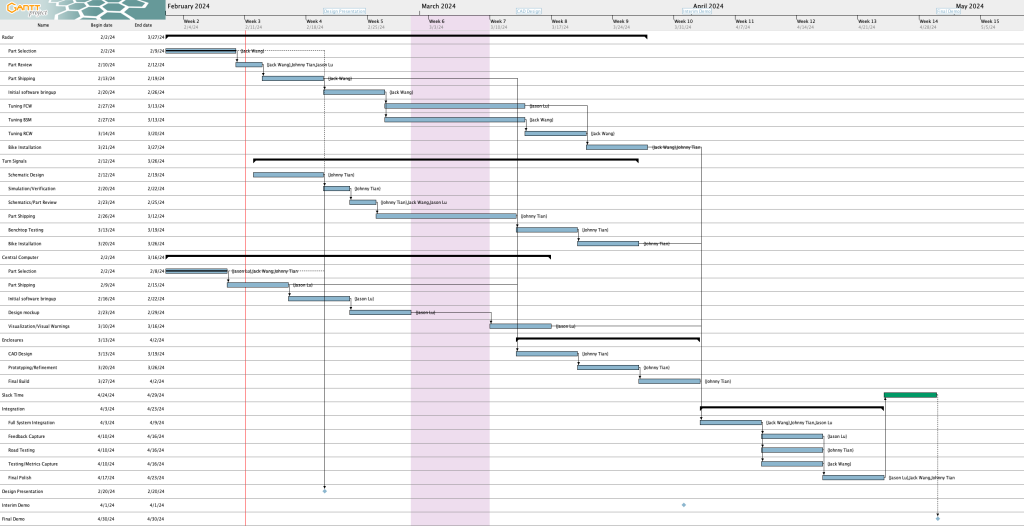This week, I focused on the following tasks:
- Working on and finishing up the proposal presentation slides
- Working on and completing the Gantt chart for our team which is displayed below:
- I originally developed the Gantt chart using a software called Project Libre which was listed in the lecture slides, but it was extremely laggy with scrolling on my computer so I switched to another software called GanttProject
- Thank God Project Libre was able to export in Microsoft Project format and that GanttProject can import it, so I didn’t lose too much time!
- There was some weird issues with the length of tasks that required manual editing, and I also ran into a bug with GanttProject where assigning people using the right click menu caused duplicate events to show up in the resource allocation page (that displays how many tasks each person has assigned). I had to use the properties page for each task as a work around.
- Attending the mandatory lab meetings and participating in the peer review process
- Researching the difference between an RPi 5 and 4 which ended up boiling down to higher performance for the RPi 5 compared to the 4 in exchange for higher power draw based on https://hackaday.com/2023/09/28/a-raspberry-pi-5-is-better-than-two-pi-4s/ and https://bret.dk/raspberry-pi-5-review/#Raspberry-Pi-5-Benchmarks
- Researching viable radars for us to use
- I discovered that the K-LD7 radar can detect vehicles up to 30 m away and reports targets over serial which is nice because we don’t need to do any signal processing unlike the similar K-LC7 which only gives us I/Q data which apparently we need to manually signal process because it only gives us the sinusoidal data
- However, I later discovered that the K-LD7 radar cannot detect stationary target detection which might pose a problem if a car is traveling at the exact same speed as the bicycle
- Because of that, I spent a lot of time researching what other radar tranceivers exist. Some interesting ones I found were:
- DISTANCE2GOL from Infineon along with other evaluation boards from Infineon because I didn’t want to design our own PCB especially with RF
- TI evaluation boards for their automotive radars – If we could use the automotive radars that would be great because they are used in real cars which are battle tested, but the evaluation boards are insanely expensive like this one
- Radars from SEEEDStudio like this 60 GHz module, but from reading the description it looked like they were more for human detection than vehicles
- Acconeer radars – These radars had great specs but the evaluation boards were pretty expensive
- Professor Tamal suggested looking at a previous team that used microwave radars for their bicycle safety system (Team B3 in F21), and they used the SEN0306 which looked promising. However, I was a little hesitant about the range since in team B3’s final report they state that it only worked up to 11 m which technically meets our requirements but is shorter than the 30 m for the K-LD7
- I eventually realized that the K-LD7 product page literally lists blind spot monitoring as a use of it, so I was much more comfortable with it
My personal progress is on track according to the schedule, my only task this week was to choose the central computer and we did.
My deliverables for the following week are:
- Get the RPi up and running
- Select a graphical framework
- Write a barebones hello world GUI application
- Select and order a display to attach to the RPi
